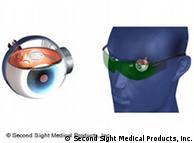Europe's first bionic hand still going strong a year on
Austrian scientists pioneer a bionic hand powered by neural signals. The
first man to get one says he can do things that would have been
impossible a year ago, such as ride a bike and eat with a fork and
knife.
For decades, humans
have speculated about upgrading, or replacing their body parts to
include bionic implants. Cochlear implants and pacemakers have become
commonplace. But the Austrian company Bionic Reconstructions is
pioneering a technique to perform elective amputations to replace
severely damaged hands with cyborg-like appendages controlled directly
by the brain.
Patrick Mayrhofer has
one of the appendages. Doctors were able to save his left arm after he
was severely electrocuted three years ago during a work accident, but
not even nine operations made it possible for Dr. Oskar Aszmann and his
team of surgeons to save Mayrhofer's left hand.
Otto Bock Healthcare,
however, was able to create a bionic replacement for Mayrhofer that
Aszmann attached to the 23-year-old a year ago.
The hand 'Michelangelo'
 Mayrhofer is able to do many things, include shake hands Mayrhofer is able to do many things, include shake hands
The company's hand, called Michelangelo, has a metallic frame, with chrome-colored joints and skinny fingers of white plastic.
"The hand is connected
to the body though a socket and electrodes sit in the sockets and
contact directly the skin," said Janos Kalmar, one of Otto Bock
Healthcare's main researchers.
It's the electrodes
that can receive neuroelectrical signals from the brain's nervous system
through the skin that set the bionic hand apart from standard
prosthetics. Even if a real hand no longer exists, the brain can still
fire neurons to move it, and the brain dutifully sends out that same
jolt to the bionic hand's electrodes.
"Using the electrodes,
we can pick up these muscle activations, small voltages on the skin, and
with the two of them, we can open and close the hand," Kalmar added.
Amputating his damaged hand
 Other bionic body parts are being tested, including the Argus, a retinal replacement Other bionic body parts are being tested, including the Argus, a retinal replacement
After seeing how the
mechanical hand could work, Mayrhofer agreed to become one of the first
people to test the bionic hand, which won't be released as a commercial
product until later this year.
But first he had to convince his family that amputating his existing hand was not a crazy idea.
"They said, 'Oh my God,
what are you doing!'" he remembered. "But with the company, I made
videos and showed them to my family, and they said, 'Wow that is
amazing! You go to Vienna and three hours later, you can grab your glass
- something you haven't been able to do with your hand for years.'"
The amputation was the
simple part, said Aszmann. More important, he added, was creating a new
neurological network that would generate a signal strong enough to power
the prosthetic what he calls "bionic reconstruction."
"You have to imagine that every hand surgical reconstruction has an immense phase of rehabilitation," Aszmann explained.
Bionic biking, climbing and eating
 Michelangelo has a metallic frame but plastic and rubber fingertips Michelangelo has a metallic frame but plastic and rubber fingertips
After months of
practice, Mayrhofer thinks of moving his hand in certain ways and his
bionic hand obeys. He uses the new hand to ride a bicycle, go rock
climbing and eat with a fork and knife.
He is the first person
to go through such a procedure in Europe, according to Aszmann, but not
the last. In April, Aszmann attached a bionic hand for a patient who had
not been able to move his human hand for the last 10 years.
The Austrian government
has given 3 million euros ($4.3 million) to the hospital to create a
new Center of Bionic Reconstruction, which is set to open in September.
Aszmann said he sees about one person a week who could become candidates for the bionic device.
"We can re-route
nerves, get new muscle attached, we can alter skeletal environment, so
that the patient in the end will have excellent conditions for a
prosthetic device," he said
Author: Sruthi Pinnameneni, Vienna / cjf
Editor: Sean Sinico
http://www.dw-world.de/dw/article/0,,15213846,00.html
| 








